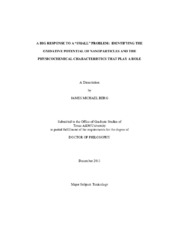| dc.description.abstract | Nanotechnology as a science is emerging rapidly. As materials are synthesized and utilized at the nanometer size scale, concerns of potential health and safety effects are arising. In an effort to elucidate the physicochemical characteristics of nanoparticles influential in toxicological studies, surface properties of metal oxide and carbonaceous nanoparticles were measured. These properties include zeta potential, dissolution and surface-bound chemical components. Subsequently, the role of these properties in oxidative stress was examined in vitro.
This work identifies the influence that pH has on the zeta potential of nanoparticles. The zeta potential has the ability to alter colloidal stability, as the largest nanoparticle agglomerate is seen at or near the isoelectric point for each of the particles tested. Furthermore, it was observed that metal oxide nanoparticles which exhibit a charged surface at physiological pH, lead to decreased in vitro cellular viability as compared to those that were neutral. Thus, nanoparticle zeta potential may be an important factor to consider when attempting to predict nanoparticle toxicity.
Real world exposure to nanoparticles is a mixture of various particulates and organics. Therefore, to simulate this particle mixture, iron oxide (Fe2O3) and engineered carbon black (ECB) were utilized in combination to identify potential synergistic reactions. Following in vitro exposure, both nanoparticle types are internalized into endosomes, where liberated Fe3+ reacts with hydroquinone moieties on the ECB surface yielding Fe2+. This bioavailable iron may then generate oxidative stress through intracellular pathways including the Fenton reaction.
As oxidative stress is common in particulate toxicology, a comparison between the antioxidant defenses of epithelial (A549) and mesothelial (MeT-5A) cell lines was made. The A549 cell line exhibits alterations in the NRF2-KEAP1 transcription factor system and therefore retains high basal levels of phase II antioxidants. Both cell types were exposed to 33 nm silica where intracellular oxidant generation coupled with markers of oxidative stress were observed. While the MeT-5A cells exhibited a decrease in cell viability, the A549 cell line did not. Therefore, proper characterization of both material and biological systems prior to toxicity testing will help to further define the risks associated with the use of nanotechnology. | en |


